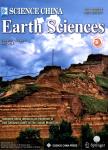Relationships between bacterial-algal proliferating and mass extinction in the Late Devonian Frasnian-Famennian transition:Enlightening from carbon isotopes and molecular fossils
Relationships between bacterial-algal proliferating and mass extinction in the Late Devonian Frasnian-Famennian transition: Enlightening from carbon isotopes and molecular fossils作者机构:China University of Geosciences Henan Polytechnic University South-Central University for Nationalities Tongji University
出 版 物:《Science China Earth Sciences》 (中国科学(地球科学英文版))
年 卷 期:2005年第48卷第10期
页 面:1656-1665页
核心收录:
学科分类:070903[理学-古生物学与地层学(含:古人类学)] 0709[理学-地质学] 07[理学] 0708[理学-地球物理学] 0704[理学-天文学]
基 金:supported by the National Natural Science Foundation of China(Grant Nos.40472020 and 40072041) the Research Fund for Doctoral Program of Higher Education of China(Grant No.2004000127) the Fund for Specially Invited Professor of Henan Polytech University
主 题:mass extinction, bacteria-algae, carbon isotopes, molecular fossils, biodiversity, Late Devonian, Guangxi, South China.
摘 要:Studies show positive shifts of inorganic and organic carbon isotope values (δ 13Ccarb and δ 13Ckerogen) from +0.43 (‰ V-PDB) to +3.54 (‰ V-PDB) and from ?29.38 (‰ V-PDB) to ?24.14 (‰ V-PDB), respectively, B* (Ba* = Ba/ (Al2O3 X 15%)) values from 0.015 to 0.144, TOC values from 0.02% to 0.21%, V/Cr values from 0.3 to 2.0, Sr/Ba values from 3.20 to 49.50 in the Late Devonian Frasnian Upper rhenana zone to the top linguiformis zone of the Yangdi sec-tion deposited in carbonate slope facies of Guilin, Guangxi, South China, which indicates that biomass, productivity, organic carbon burial and salinity increase and that oxygenation near the boundary between sediments and waters decreases from the Late Devonian Frasnian Upper rhenana zone to the top linguiformis zone. Abundance of molecular fossils increases and normal alkanes, isoprenoid hydrocarbon, terpanes and steranes are dominated from the Late Devonian Frasnian to the bottom of Famennian, which shows that the predecessors of molecular fossils of the Frasnian-Famennian (F-F) transition are dominated by marine phytoplankton, zooplankton and benthic bacteria with no photosynthesis. Therefore, it is considered that the F-F transitional mass extinction with a multistage, selection and global synchronizing was caused by bacte-rial-algal proliferating, continuing deterioration of the shallow marine ecoenvironment of the mid-dle-lower latitudes. A simple cause and effect chain can be expressed as: appearance of seed plants and multi-storied forests → enhanced chemical and biochemical weathering and pe-dogenesis → wide development of soils → increasing riverine nutrient fluxes in epicontinental sea → from superoligotrophic to eutrophic in epicontinental sea → proliferating of marine phyto-plankton and zooplankton → frequent red tide and anoxia → mass extinction of shallow marine organisms in the middle-lower latitudes. It is worth notice that the factor drawdown of atmos-pheric Pco2, climatic cooling and sea level falling c



